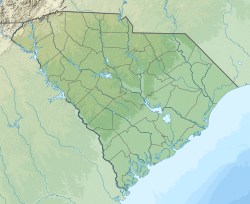| Edisto River | |
|---|---|
 Feeding ducks in winter time at Edisto Gardens alongside the Edisto River, Orangeburg, South Carolina | |
 Edisto River watershed | |
| Etymology | Named for the Edisto people |
| Location | |
| Country | United States |
| State | South Carolina |
| Counties | Charleston, Colleton, Dorchester, Bamberg, Orangeburg |
| Physical characteristics | |
| Source | |
| • coordinates | 33°15′46″N80°53′11″W / 33.262659°N 80.8864854°W |
| Mouth | |
• location | Edisto Beach, Atlantic Ocean |
• coordinates | 32°39′16″N80°23′17″W / 32.65444°N 80.38806°W |
• elevation | 0 ft (0 m) |
| Length | over 250 mi (400 km) |
The Edisto River is one of the longest free-flowing blackwater rivers in North America, [1] flowing over 250 [1] meandering miles from its sources in Saluda and Edgefield counties, to its Atlantic Ocean mouth at Edisto Beach, South Carolina. It rises in two main tributaries (North Fork & South Fork) from springs under the Sandhills region of West Central South Carolina, just to the south of the Piedmont Fall Line. It is the longest and largest river system completely contained within the borders of South Carolina. Its name comes from the Edisto subtribe of the Cusabo Indians. [2]
Contents
- Conservation
- Wildlife
- Edisto Riverkeeper
- Friends of the Edisto
- Edisto River Canoe and Kayak Trail
- History
- See also
- References
Near the coast, part of the river was once known as the Ponpon River. The Dawhoo River (sometimes Dawho, or Dawhoe) connects the Edisto to the North Edisto River, also the confluence of the Wadmalaw and the Toogoodoo rivers, where they meet the Atlantic Ocean. Between the coast and the Dawhoo River, the river is known as the South Edisto River. [3]
The Edisto system flows through only one major town or city, Orangeburg, the location of Edisto Gardens (on the North Fork). The river system, being blackwater throughout its entire length, flows through highly intermittent bottom swampland. During an excessively rainy season, the river will leave its main channel, with its flow basin increasing to over a mile or more of total width. The lower Edisto basin forms a crucial part of the ACE Basin, an area that encompasses its bottomlands confluence with the Ashepoo and Combahee river basins. [4]
A major tributary is Four Holes Swamp, which is unique in that it has no single defined channel, but rather a network of braided channels.

